|
1.
CENTRAL AND WEST AFRICA
Cameroon
Unseasonal heavy rains have swept across Cameroon far
earlier than expected triggering widespread transport
delays. Travel restrictions on key laterite roads are slowing
truck movements creating log and sawnwood stockpiles at
mills, an unwelcome burden in already sluggish markets.
The Chinese market remains a challenge say producers.
Duties on African timbers have reportedly been removed
but exporters report no surge in orders and business
sentiment is low. Only high‐value species such as Azobé,
Ovangkol and Okan continue to keep a handful of mills
running buoyed by modest enquiries from Europe and the
Middle East.
Douala Port is said to be severely backlogged with ships
waiting sometimes a week to berth and with this comes
substantial demurrage charges. Opeations at Kribi Port are
said to be steady but Kribi handles a smaller volume than
Douala. Containers remain available but shipping delays
are squeezing export timelines.
Gabon
Unverified reports say Gabon’s industry association,
UFIGA, has lodged a request with both the Forestry and
Transport ministries to address inadequate rail wagon
allocations for wood product transport. Priority remains
with manganese shipments, forcing sawmills to contend
with severe backlogs.
With unexpected rains now extending into northern
provinces, laterite road repairs remain on hold. A round
trip from Makokou or Okondja to Libreville can now take
up to a week, leading many truckers to refuse to haul and
mills to amass timber stocks.
Producers say market demand remains muted with the
exception of Azobé shipments to the Netherlands,
Ovangkol and Béli to China and Okoumé to the
Philippines. Padouk exports to Belgium ‘limp’ along
under CITES‐related documentation delays.
Following government intervention, SEEG’s power cuts
have ceased entirely. In mid month the Ministry
summoned SEEG’s board and mandated the final
installations on the two Turkish powerships. Since then,
Libreville has enjoyed uninterrupted electricity service.
Republic of Congo
Southern Congo has entered its dry season, though
northern areas under Cameroon’s rain belt still experience
intermittent showers. Harvesting remains constrained by
low international demand and veneer mills, bound by
long‐standing contracts, operate on a single shift.
Transport to Pointe-Noire via the Maloukou corridor is
unchanged. River transport operations feed rail or road
movement of timber with no new disruptions reported.
Port operations at Pointe-Noire continue smoothly despite
occasional vessel backlogs.
Timber exports are steady but limited by existing quotas
and CITES restrictions. Overall production and shipments
remain subdued in line with the broader market downturn.
The latest edition of the Republic of Congo's APV-FLEGT
newsletter (January-February-March 2025) focuses on the
issue of supplying the local market with timber,
highlighting the launch of the Private Sector Support
Project – Domestic Timber Market (ASP MIB Congo).
The aim is to strengthen the structure, competitiveness and
sustainability of the domestic timber sector in the Republic
of Congo. It is part of a drive to formalise a sector that has
remained informal for too long, despite its important
economic role.
ATIBT reports that in the editorial of the newsletter, the
National FLEGT Focal Point, Théophile Ntiakoulou
Loulébo, emphasises that this project responds to a long-
standing concern of the Congolese government, identified
in particular in the 2020 Forest Code, to improve the
supply of processed wood for the domestic market and to
better regulate artisanal practices.
See: https://apvflegtcongo.com/
and
https://www.atibt.org/en/news/13655/the-domestic-timber-
market-mib-project-featured-in-the-republic-of-congo-apv-flegt-
newsletter
Central African Republic
The correspondent reports only six timber operators
remain active in the Central African Republic. They are
trucking high-value redwood logs overland to Bertoua,
Cameroon and onward (1,200 km) to Douala for export.
ATIBT has reported on the joint initiative of the African
Forest Forum (AFF) and the Center for Development and
Environment (CDE) at the University of Bern
themed: “The AfCFTA and intra-African timber trade for
inclusive green growth.” a collaborative online event from
30 June 30 to 11 July 11 2025.
Stakeholders from across Africa will have the opportunity
to explore the intersection of the African Continental Free
Trade Area (AfCFTA), intra-African timber trade and
green growth strategies. The discussions aim to strengthen
collaboration and policy alignment in support of
sustainable and inclusive development across the
continent.
See: https://www.atibt.org/en/news/13652/community-of-
practice-afcfta-and-intra-african-timber-trade-a-collaborative-
online-event-from-june-30-to-july-11-2025
and
https://afforum.org/events/community-practice-afcftas-role-
promoting-sustainable-intra-african-timber-trade-inclusive
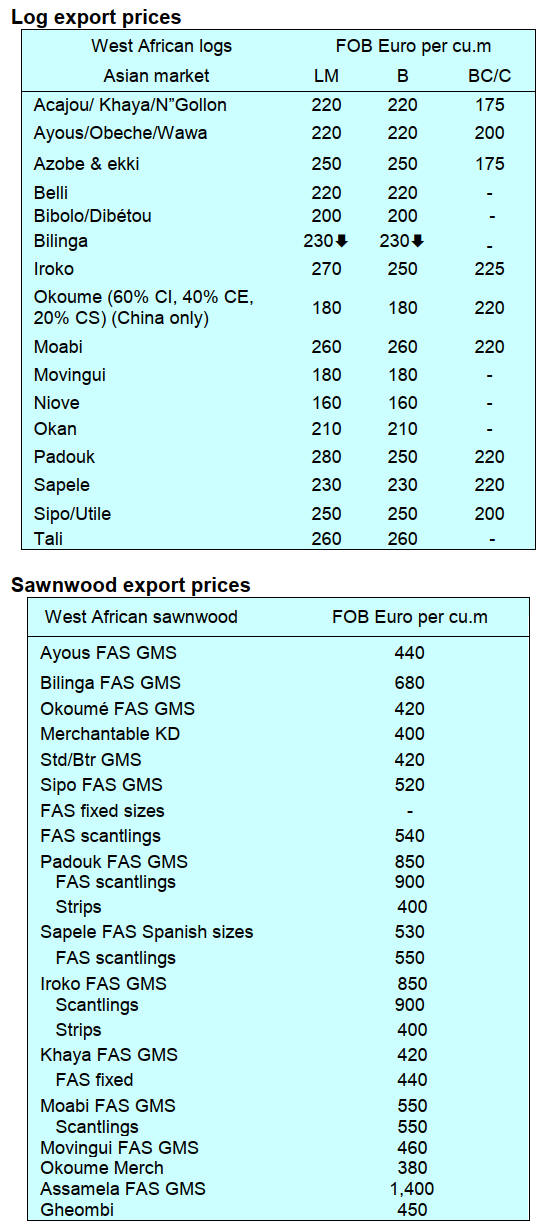
Through the eyes of industry
The latest GTI report lists the challenges identified by the
private sector in the Republic of Congo and Gabon.
See: https://www.itto-
ggsc.org/static/upload/file/20250616/1750055807148798.pdf
2.
GHANA
Billet exports double, India accounts for most
The Timber Industry Development Division (TIDD) of the
Forestry Commission (FC) report for the first four month
of this year showed that Ghana’s timber and wood product
exports for the period were 47,492 cu.m. and earned
Eur86.76 million.
A total of eighteen different wood products contributed to
exports. The table below shows product details for the first
four months of 2025 compared to the same period in 2024.
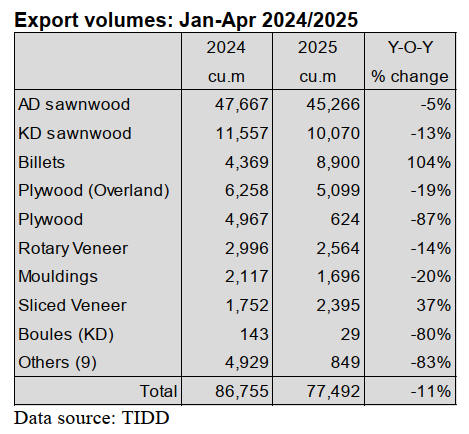
Exports of billet accounted for 12% (8,900 cu.m) of the
total export volume for the period against 5% (4,369 cu.m)
recorded in 2024 representing a doubling of export
volumes.
Billet exports along with air-dried sawnwood (58%), kiln
dried sawnwood (13%), plywood to the regional market
(6%) and rotary veneer (3%) accounted for 92% of the
total export volume for 2025 (77,492 cu.m). For the same
products last year, the volume was 86,755 cu.m.
Revenue from the country’s wood product exports for the
four-months period totalled Eur36.49 million. The table
below shows the breakdown of products receipts with
billets recording a significant increase of 107% to Eur2.72
million.
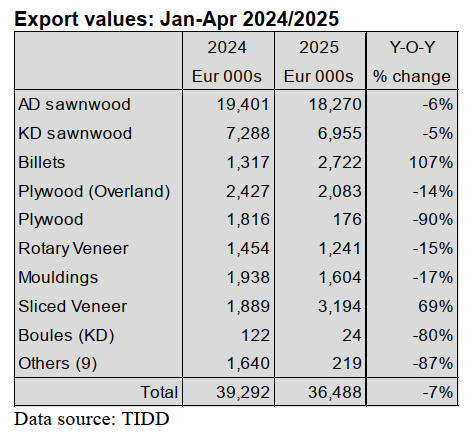
In 2025 India accounted for a significant 8,854 cu.m of the
total Billet export volume with Barbados accounting for
46 cu.m. The major species for billet were teak and
gmelina accounting for 86% and 14% respectively. The
average unit price of billets registered an almost 2%
increase from Eur301/cu.m in January-April 2024 to
Eur306/cu.m in the same period of 2025.
Ghana-China Business Summit 2025
A Ghana-China Business Summit 2025 was held in Accra
bringing together over 90 Chinese investors and key
stakeholders to explore opportunities for industrial growth
and partnerships between the two nations. The Association
of Ghana Industries (AGI) was in attendance with key
executives including Dr. James Asare-Adjei, past
president of AGI and Mr. Eric K. Defor, Chairman of the
AGI Construction Sector.
During the summit, the government’s Chief of Staff,
Julius Debrah assured Chinese participants that Ghana
welcomes supports and will assist in establishing
manufacturing plants.
AGI members who participated in the event engaged
directly with Chinese investors on opportunities in
pharmaceuticals, real estate, agribusiness and
manufacturing exploring potential collaborations and joint
ventures.
With bilateral trade between Ghana and China exceeding
US$9.5 billion in 2024, the summit aimed to catalyse joint
ventures, market expansion strategies and knowledge
transfer initiatives positioning Ghana as a strategic entry
point for Chinese investment into West Africa.
See: https://agighana.org/ghana-china-business-summit-2025-
opens-with-strong-calls-for-collaboration-and-industrial-
transformation/
Tree nursery to produce indigenous seedlings
The biggest indigenous tree nursery facility in Africa has
been inaugurated at Bassengele, a farming community in
Bibiani Anhwiaso- Bekwai Municipality in the Western
North Region of Ghana.
The facility, which has the capacity to produce 5 million
indigenous seedlings annually, features a cutting-edge
irrigation system with almost half a million dollars’ worth
of investment committed. Among the indigenous
commercial tree species targeted are mahogany, wawa,
amire and odum.
The company, in partnership with the Forestry
Commission as part of its long-term commitment, hopes to
restore 2,000 hectares of degraded land this year, with 350
hectares expected to be restored in June 2025 as part of the
Tree for Life initiative championed by President John
Dramani Mahama.
See: https://fcghana.org/fc-ce-lauds-rainforest-builder-ghana-for-
inaugurating-africas-largest-native-tree-species-nursery/
Seaports to run 24-hour service
Ghana’s ports of Takoradi and Tema are soon to
implement a 24-hours service following President John
Dramani Mahama’s initiative of a broader national
strategy to stimulate economic activity through continuous
production and trade.
The announcement comes ahead of the official rollout of
the country’s 24-hour economy policy. The President
described the policy as a “game-changing strategy” aimed
at unlocking Ghana’s economic potential, particularly in
export-oriented sectors.
Ghana’s wood product exports by sea go through both the
Takoradi and Tema Ports where the TIDD has offices for
the final inspection of these wood products.
See: https://thebftonline.com/2025/06/12/mahama-declares-july-
1-start-for-24-hour-economy/
Ghana’s intra-Africa exports reached US$4.8 bil. in
2024
Ghana accounted for nearly 6% of the intra-African trade
in 2024 solidifying its position as one of the continent’s
top trading economies. This was revealed in the 2024
Africa Trade Report released on the sidelines of the 32nd
Afreximbank Annual Meetings in Abuja, Nigeria.
The figure represents a marginal increase over Ghana’s
share in 2023 and includes both exports and imports with
other African countries. According to the report, Ghana’s
total exports to Africa reachedUS$4.8 billion in 2024, up
from US$3.5 billion the previous year.
Ghana’s wood product exports to African countries
accounts for around 10% of the total export volume. This
places Africa at the third largest market destination after
Asia and Europe. Of the total volume exported to Africa,
more than 70% goes to the regional ECOWAS (Economic
Community of West Africa States) markets.
See: https://media.afreximbank.com/afrexim/African-Trade-
Report_2024.pdf/
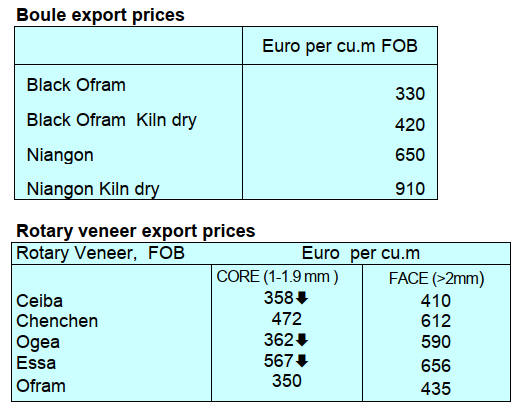
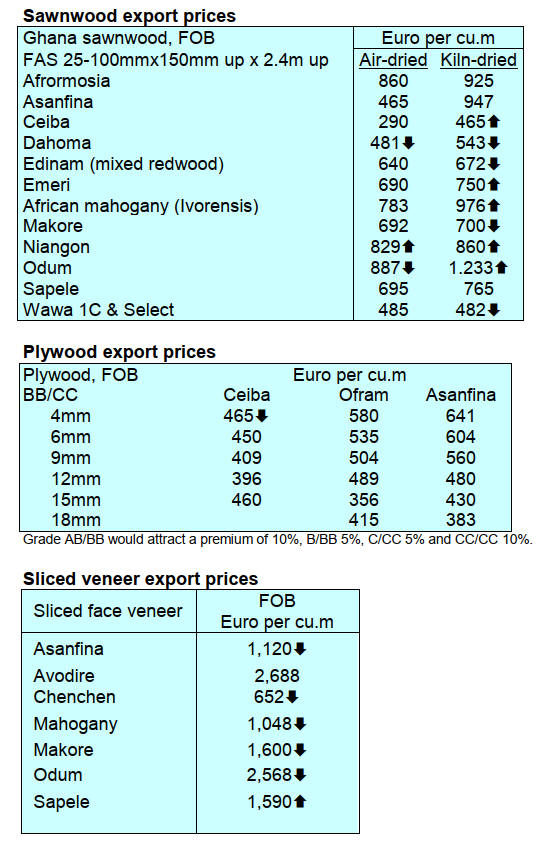
Through the eyes of industry
The latest GTI report lists the challenges identified by the
private sector in Ghana.
See: https://www.itto-
ggsc.org/static/upload/file/20250616/1750055807148798.pdf
3. MALAYSIA
Uncertain times ahead
Malaysia’s trade performance is expected to remain steady
in the near term supported by exports ahead of potential
US tariff hikes and continued diversification in export
markets. Economists caution on the outlook for the second
half of the financial year 2025.
Bank Muamalat Malaysia Chief Economist, Afzanizam
Abdul Rashid, is reported as saying Malaysia’s trade
remained robust in May building on April’s strong
momentum. In April total trade rose 18.2% year-on year
with both exports and imports posting strong double-digit
increases for the month. Exports expanded by 16% and
imports were up by 20%.
Afzanizam noted that the 90-day pause in US tariff hikes
had led to front-loading behaviour among Malaysian
exporters.
The sharp surge in exports to the US (up 46% YoY in
April) and Taiwan P.o.C (up 45%) suggests strategic
acceleration of shipments ahead of potential trade policy
changes.
See: https://www.thestar.com.my/business/business-
news/2025/06/20/uncertainty-to-cloud-2h25-trade-
performance#goog_rewarded
Could timber exports may gain a competitive edge in
the US?
Malaysia’s timber exports may gain a competitive edge in
the US market due to higher tariffs imposed on regional
rivals such as Vie Nam and Indonesia. Viet Nam, a
leading furniture exporter in the region faces tariffs as high
as 46% compared with Malaysia’s levy of 24% according
to Wan Tarmeze, Director of Forest Products Division,
Forest Research Institute Malaysia (FRIM).
The US is the largest buyer of Malaysian furniture
accounting for over half of furniture exports. The tariffs
announced inApril have been paused for 90 days until
early July and may be paused further.
On the challenges faced by the timber industry Wan
Tarmeze said Malaysia’s furniture sector primarily relies
on processed wood rather than solid timber, with wood-
based materials accounting for up to 85% of inputs in the
furniture/ industry.
When asked how Malaysia can position itself as a high-
value timber exporter rather than a volume exporter, he
said the shift ultimately depends on the industry “This has
been a long-standing conversation as Malaysia is still
heavily reliant on the original equipment manufacturer
(OEM) model, manufacturing wood products for others
without having its own strong, internationally recognised
brands.
OEM refers to manufacturing products for other brands,
whereas original brand manufacturers (OBM) involve
developing and marketing products under one’s own brand
name. Wan Tarmeze said that despite the government’s
repeated calls for the industry to move from being OEMs
to OBMs, the shift has yet to happen.
See:
http://theborneopost.pressreader.com/article/282149297287449
Tawau Port congestion
Sabah Timber Industries Association (STIA) has called for
an assurance from the Sabah State government that it will
address the Tawau Port congestion that began in April.
STIA President, Tan Peng Juan, said STIA members,
especially exporters, are demanding proactive steps and
backup plans to resolve existing issues at the port to
prevent future recurrences of port congestion.
Tan had likened the recent Tawau Port congestion incident
to a ‘time bomb’ as the same problem could happen when
one of the port’s two cranes break down again.
On 10 May it was reported that a total of 200 containers
with wood products were stranded at the Tawau Port due
operational problems. STIA members faced shipment
delays, incurred demurrage fees and extra container rental
costs. The delays for over a month had significantly
affected logistics efficiency which caused setbacks for
businesses reliant on timely cargo processing.
See: https://www.dailyexpress.com.my/news/260704/no-tawau-
port-repeat-please/
Through the eyes of industry
The latest GTI report lists the challenges identified by the
private sector in Malaysia.
See: https://www.itto-
ggsc.org/static/upload/file/20250616/1750055807148798.pdf
4.
INDONESIA
Anti-dumping/subsidy investigation on
plywood
The Ministry of Trade (Kemendag) is fully supporting
Indonesian businesses facing anti-dumping and anti-
subsidy investigations by the US Department of
Commerce regarding hardwood and decorative plywood
exports. Kemendag will assist Indonesian entrepreneurs in
preparing their defence and completing questionnaires.
Around one-third of Indonesia's hardwood and decorative
plywood production is exported to the US.
See: https://www.antaranews.com/berita/4905025/kemendag-
bela-pelaku-usaha-ri-hadapi-penyelidikan-kayu-lapis-di-as
and
https://www.trade.gov/commerce-initiates-antidumping-duty-
and-countervailing-duty-investigations-hardwood-and-decorative
Premier woodworking and furniture for Jakarta
For the first time major international trade fairs; Interzum
Jakarta, IHFI and IFMAC/WOODMAC will be held
concurrently in Jakarta at JIExpo Kemayoran 24-27
September.
This collaborative effort aims to create a comprehensive
platform for the entire woodworking and furniture industry
value chain. The goal is to foster a connected and mutually
reinforcing industrial ecosystem, facilitating cross-sector
collaboration from raw materials and technology providers
to component suppliers and interior design solutions.
See: https://wartaekonomi.co.id/read571342/southeast-asias-
premier-woodworking-furniture-manufacturing-industry-hub-
akan-digelar-di-jakarta
Industry needs machinery upgrades
To raise the quality and competitiveness of Indonesia's
furniture and wood products machinery upgrades are
crucial. Jimmy Chandra, Deputy Chairman for R&D and
Regulations at the Indonesian Sawmill and Woodworking
Association, emphasised that investing in advanced
machines and technologies is the only way to achieve
efficiency and improve product quality.
Chandra also stressed the importance of Indonesian
industry players not just hosting exhibitions but also
actively participating in international events. He urged the
Indonesian government to provide subsidies or support for
local companies to showcase their products on the global
stage similar to the support provided by some other
countries.
He added Indonesian wood product manufacturers are
urging the government to lower import duties on
production machines. According to Chandra the industry
faces challenges due to limited technological utilisation
while other countries are using more efficient, modern
machinery.
Chandra specifically requested a 20% reduction on import
duties for the latest generation of production machines. He
stressed that modernising production machinery is
essential for the woodworking industry to be more
competitive in international markets.
See: https://www.medcom.id/ekonomi/bisnis/GNGz86xK-
pelaku-industri-furnitur-membutuhkan-pembaruan-mesin
and
https://www.tribunnews.com/bisnis/2025/06/19/pemerintah-
perlu-turunkan-bea-masuk-mesin-produksi-untuk-genjot-daya-
saing-industri-kayu-olahan.
Ministry acknowledges Indowood Expo 2025 a boost
for exports
The Ministry of Industry has praised the Indonesia
Forestry and Woodworking Machinery Expo (Indowood
Expo) 2025 as a vital initiative to bolster national wood
industry exports and drive innovation.
Putu Juli Ardika, Director General of Agro Industry at the
Ministry of Industry, said that the Expo provides an
important platform for the development of Indonesia's
woodworking machinery and equipment industry as well
as the expansion of the domestic furniture market.
Ardika also pointed to a rising Industrial Confidence Index
(IKI) which hit 52.11 in May 2025 underscoring the need
for continuous efforts to sustain and improve export
performance. He concluded that the Indowood Expo is
a strategic platform crucial for supporting the growth of
Indonesia's wood industry.
See: https://jatim.antaranews.com/berita/935261/kamenperin-
apresiasi-penyelenggaraan-indowood-expo-2025
and
https://www.jawapos.com/ekonomi/016164492/nilai-ekspor-
produk-kayu-indonesia-tembus-usd-32-miliar-indowood-expo-
2025-dorong-industri-perkayuan-naik-kelas
Increased scrutiny of permits amid mining concerns
The Indonesian Ministry of Forestry is increasing its
oversight of forest area use permit (PPKH) holders,
particularly in light of heightened environmental concerns
surrounding mining activities in Raja Ampat, Southwest
Papua. Director General of Law Enforcement, Dwi
Januanto Nugroho, emphasised the need to improve
supervisory business processes for issued permits.
The recent public outcry over nickel mining in the
ecologically vital Raja Ampat islands presents an
opportunity for the ministry to ensure good governance.
See: https://en.antaranews.com/news/359097/ri-govt-bolsters-
scrutiny-of-forest-area-use-permit-holders
Indonesia champions indigenous rights
Indonesia is a strong advocate for indigenous peoples'
rights in the context of climate change actively
participating in the Facilitative Working Group on Local
Communities and Indigenous Peoples Platform (FWG
LCIPP).
Yuli Prasetyo Nugroho, from the Ministry of Forestry,
highlighted Indonesia's consistent engagement with FWG
LCIPP since its inception. Recently, Indonesia showcased
its Customary Forest Programme in Germany detailing
achievements since 2016. This programme involves 156
Indigenous Law Communities managing 332,505 hectares
of customary forests across 19 provinces and 41
districts/cities.
During the LCIPP Annual Dialogue, Indonesia
underscored the profound connection of its indigenous
peoples (Masyarakat Hukum Adat) to natural resources.
The Ministry emphasised the crucial role of customary
forests in both local development and broader climate
change initiatives, recognising that these communities
maintain their identity and contribute significantly to
forest management despite evolving socio-economic
landscapes.
See: https://en.antaranews.com/amp/news/360993/indonesia-
advocates-indigenous-communities-progress-at-fwg-lcipp
SFM and digitalisation cooperation with Finland
The Papua Provincial Administration recently met
with Finnish Ambassador to Indonesia, Jukka-Pekka
Kaihilahti, to discuss potential cooperation on SFM and
digitalisation.
Ambassador Kaihilahti highlighted Finland's strong
emphasis on environmental sustainability and expressed
hope that collaboration in these areas could be realised in
Papua. He reiterated Finland's commitment to
strengthening ties with Indonesia, particularly in
telecommunications, forestry and digitalisation, which are
also priorities for Papua.
Acting Regional Secretary of Papua, Suzana D. Wanggai,
welcomed Finland's interest especially concerning
environmental preservation, digitalisation and approaches
that respect indigenous values.
See: https://en.antaranews.com/news/360717/papua-explores-
cooperation-in-forest-management-with-finland
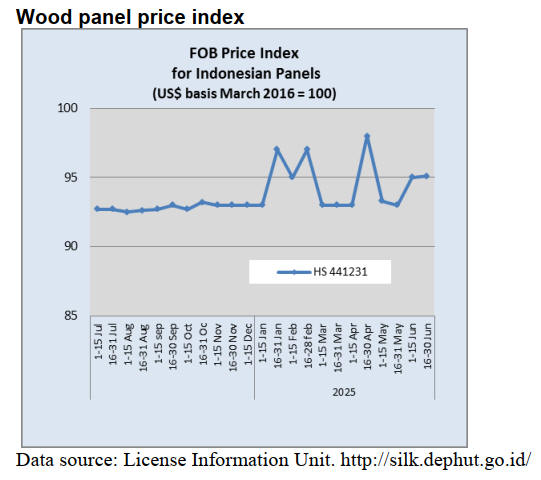
Through the eyes of industry
The latest GTI report lists the challenges identified by the
private sector in Indonesia.
See:https://www.itto-
ggsc.org/static/upload/file/20250616/1750055807148798.pdf
5.
MYANMAR
6.
INDIA
Manufacturing emerging as
attractive sector for
investors
In a special report, S&P Global says India’s manufacturing
sector is emerging as an increasingly attractive destination
for investors as the country makes progress in
competitiveness and is making its manufacturing sector
more attractive to global investors.
The report also highlights that over the past three decades
its core sectors, manufacturing, agriculture and services
have grown in step with demographic shifts and structural
changes and will see demand grow as the economy
advances. The latest report from S&P Global comes after
India’s manufacturing sector expanded at its fastest pace
in 10 months in April, driven by strong demand and a
sharp rise in output.
“An analysis of S&P Global Market Intelligence’s index
over time indicates that India has made notable progress in
enhancing its competitiveness and making its
manufacturing sector more attractive to investors” the
report said.
See: https://www.spglobal.com/en/research-insights/special-
reports/india-forward/india-manufacturing-opportunity-amid-
global-trade-uncertainty
New Zealand trade mission
New Zealand’s Minister of Forestry, Todd McClay,
revealed that reciprocal trade missions with India this year
are expected to promote New Zealand's forestry systems
and sustainable management practices.
He added "the outbound mission is aimed at strengthening
trade links, deepening industry ties and unlocking greater
value for both countries” New Zealand's wood exports to
India surged from US$9.5 million in 2023 and are forecast
to reach US$76 million this year.
See: https://www.rnz.co.nz/news/indonz/564363/todd-mcclay-
unveils-two-way-forestry-trade-missions-with-india
Outdated property Registration Act to be replaced -
will drive sector growth
The Central Government has introduced a draft
Registration Bill, 2025, a long anticipated development in
India’s property registration framework. Replacing the
outdated Registration Act of 1908, this bill aims to bring
clarity, efficiency and transparency to real estate
transactions through digitilisation and legal reforms.
The Registration Bill 2025, says the press, has the
potential to make transactions regarding the Indian real
estate sector, faster, secure and more transparent. In
addition, it is claimed the Bill lays the groundwork for
deeper investment and innovation in Indian real estate.
The most exciting part is the vision of interconnected
digital property registers linking registration data with land
records, municipal databases and financial institutions
which will assist developers.
See: https://housing.com/news/centre-releases-draft-of-the-
registration-bill-to-overhaul-property-registration/
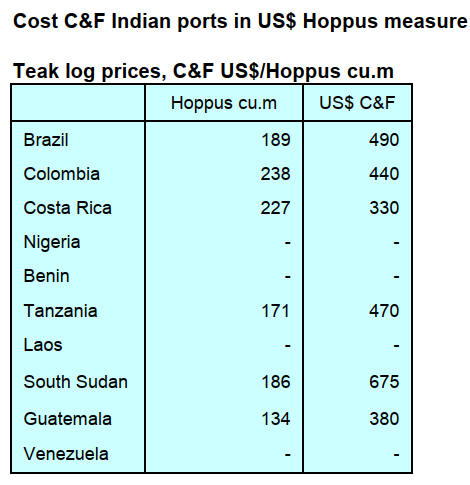
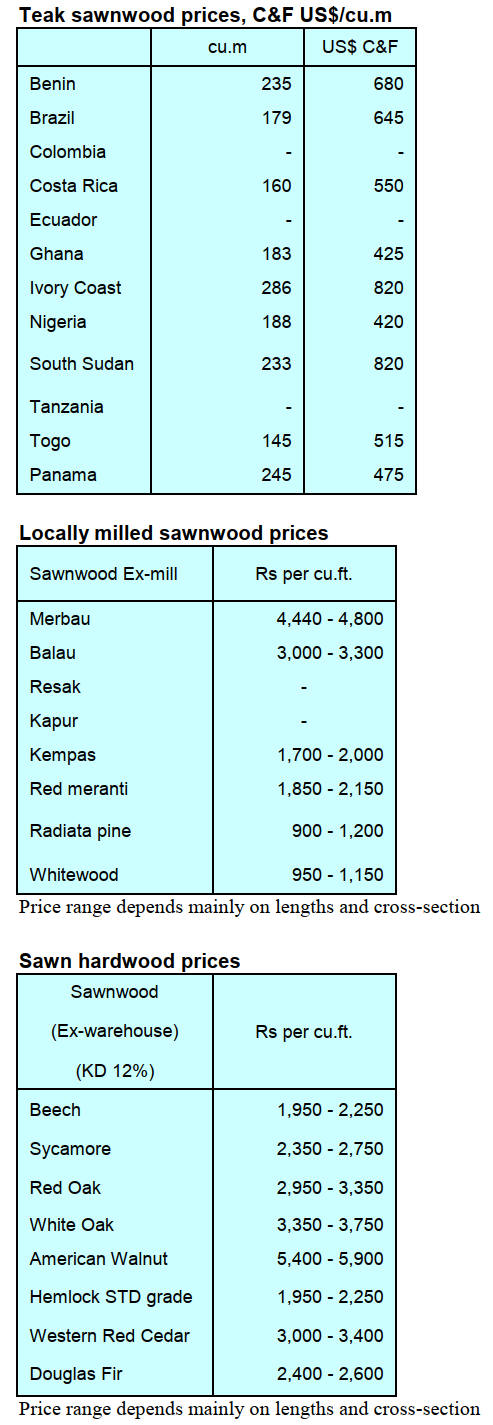
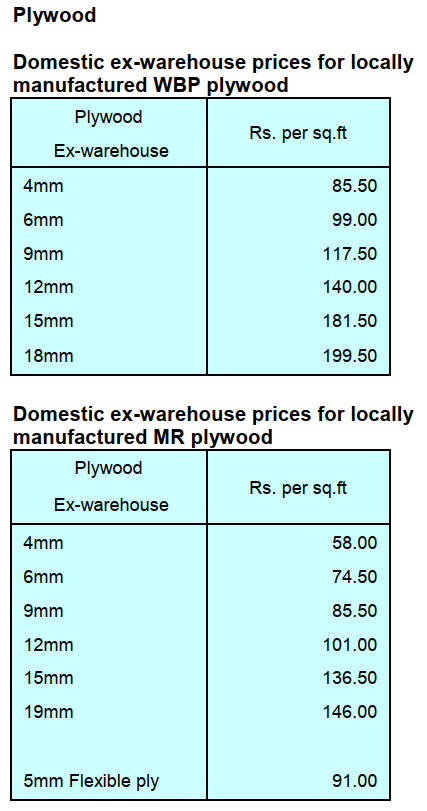
7.
VIETNAM
Wood and Wood Product (W&WP) trade
highlights
According to the Viet Nam Customs Department W&WP
exports in May 2025 reached US$1.4 billion, down 2.5%
compared to April 2025, but up 5% compared to May
2024. WP exports accounted for US$995.5 million, up 2%
compared to April 2025 and up 13% compared to May
2024.
In the first 5 months of 2025 W&WP exports totalled
US$6.8 billion, up 9% over the same period in 2024. WP
exports alone fetched US$4.7 billion, up 10% over the
same period in 2024.
W&WP exports to China in May 2025 valued at US$137.7
million, down 36% over the same period in 2024. In the
first 5 months of 2025 W&WP exports to China stood at
US$707.3 million, down 20% over the same period in
2024.
In May 2025 exports of kitchen furniture earned US$121
million, up 2% compared to May 2024. In the first 5
months of 2025 exports of kitchen furniture brought in
about US$545 million, up 3% over the same period in
2024.
In May 2025 W&WP imports to Viet Nam amounted to
US$301 million, up 22% compared to April 2025 and up
16% compared to May 2024. In the first 5 months of 2025,
Viet Nam spent US$1.2 billion for W&WP imports, up
18% over the same period in 2024.
Viet Nam's pine imports in May 2025 were 100,300 cu.m,
worth US$21.1 million, up 20% in volume and 22% in
value compared to April 2025 and an increase of 18% in
volume and an increase of 13% in value compared to May
2024. In the first 5 months of 2025, imports of pine stood
at 367,500 cu.m, worth US$76.1 million, up 16% in
volume and 10% in value over the same period in 2024.
Viet Nam’s imports of raw wood (logs and sawnwood)
from ASEAN countries in May 2025 reached 79,000 cu.m,
with a value of US$22.5 million, up 5% in volume and 6%
in value compared to April 2025 bringing the total volume
of raw wood imported from ASEAN countries in the first
5 months of 2025 to 361,880 cu.m, with a value of
US$101.86 million, down 7% in volume and down 6% in
value over the same period in 2024.
Viet Nam/US promote sustainable timber trade and
legal supply chains
The US remains Viet Nam’s largest market and accounted
for 55% of the country's total wood product exports in
2024. Key products included wooden furniture, plywood,
doors and handicrafts.
Enterprises and associations in the timber industry have
emphasised the need to increase imports of US legal
timber for processing and re-export as a way to ensure
sustainable timber trade and legal supply chains.
Speaking at a workshop on Viet Nam/US timber and wood
products trade held on 24 June by the Department of
Forestry and Forest Protection under the Ministry of
Agriculture and Environment, Viet Nam’s leading timber
associations and Forest Trends, Vice Chairman and
Secretary General of the Viet Nam Timber and Forest
Products Association (VIFOREST) Ngo Sy Hoai said that
in 2024 Viet Nam exported wood and wood products
worth US$9 billion to the US, up 24% year-on-year.
Viet Nam imported US$316.36 million worth of timber
from the US in 2024, up 33% year-on-year, and accounted
for 11% of Viet Nam's total wood imports. The top three
imported items were sawnwood, logs and veneer.
Hoai stressed that US regulations such as the Lacey Act,
require wood imports to be legal and traceable. Exporters
must comply with documentation requirements including
export certificates and self-certification of origin.
Viet Nam has banned natural forest logging since 2014,
focusing instead on sustainable plantation forestry. The
country now relies mainly on 3 million hectares of planted
forests, mainly acacia and eucalyptus and 1 million
hectares of rubberwood plantations.
Until now, 700,000 ha of commercial forests in Viet Nam
have been certified. Viet Nam aims to reach 70% certified
plantation coverage by 2030.
Imports of tropical timber into Viet Nam have dropped
significantly from over 2 million cubic metres in 2015 to
700,000 cubic metres in 2024.
Viet Nam’s Timber Legality Assurance System
(VNTLAS), which was developed under a voluntary
partnership agreement (VPA) between the European
Union and Viet Nam on forest law enforcement
governance and trade (FLEGT), was launched in 2020 and
updated in 2024.
Hoai highlighted that Viet Nam has become one of the top
suppliers of timber to the US and one of the largest
importers of US wood. He said both sides have strictly
followed regulations including the Lacey Act and
effectively resolved trade disputes such as the US Section
301 investigation. He called for continued collaboration to
promote legal, sustainable and mutually beneficial timber
trade between the two countries.
At the workshop, Director of the Department of Forestry
and Forest Protection, Tran Quang Bao, revealed that new
regulations, including those related to business
classification, traceability of forest products, geographical
zoning are expected to be issued.
The regulations will help develop a transparent digital
transformation system, meeting the requirements of
traceability, Bao said.
He noted that his Department is ready to accompany
associations and businesses to assure international partners
that Viet Nam is a tropical country but has stopped
commercial harvesting in natural forests. Viet Nam does
not use wood material from natural forests for export and
is completely transparent in the supply chain and legal
system.
See:https://en.Viet Namplus.vn/Viet Nam-us-promote-
sustainable-timber-trade-legal-supply-chains-
post321542.vnp?utm_source=chatgpt.com
Digital transformation boosts transparency
At the Viet Nam/US Wood Trade Dialogue held in Hanoi,
industry representatives agreed on the need to increase
imports of raw wood from the US for processing and re-
export to the US and other markets. Industry
representatives and associations agreed to enhance
international cooperation to improve the reputation of Viet
Nam’s timber sector while ensuring transparency and
compliance with legal frameworks across the supply
chain.
Hoai affirmed that Viet Nam is emerging as a top supplier
of wood and wood products to the US and one of the
largest consumers of US wood. Laws such as the Lacey
Act are strictly observed by both sides. Viet Nam has
made sustained efforts to deal with concerns over legality
and sustainability.
The wood trade between the two countries not only
delivers significant economic value but also offers added
benefits: US consumers gain more access to high-quality,
legally sourced, reasonably priced products.
To Xuan Phuc, Director of the Forest Policy Trade and
Finance Program at Forest Trends stated that several
misconceptions about Viet Nam’s wood sector persist.
First, while some believe Viet Nam imports high-risk
timber for re-export most imports serve the domestic
market and import volumes have dropped significantly.
Second, Viet Nam is not a trans-shipment hub for China’s
wood supply. Annual wood imports total only about US$1
billion, with higher-risk items (e.g., panels and furniture)
accounting for just US$200–300 million.
Third, the view that Viet Nam’s export growth threatens
its forest resources is inaccurate. The country has closed
natural forests and does not use domestic natural timber
for exports. Exported products are primarily made from
plantation timber, rubber wood or legally sourced imports
from positive geographic regions.
Phuc urged relevant agencies to actively share information
to deepen accurate understanding of the sector’s role,
thereby mitigating risk and expanding markets. Authorities
and industry associations should shift their approach by
engaging more directly with export markets and
environmental organisations, while joining international
associations to strengthen Viet Nam’s global wood
industry presence.
See: https://english.vov.vn/en/economy/digital-transformation-
boosts-transparency-supports-Viet Nam-us-wood-trade-
post1209559.vov?utm_source=chatgpt.com#google_vignette
Viet Nam’s wood industry in 2025 - navigating
challenges and seizing opportunities
Viet Nam’s wood industry is a vital component of the
nation’s economy, consistently ranking among the top
exporters. The sector is evolving, focusing on sustainable
practices and value-added products, while also navigating
challenges such as trade tensions and tariffs.
With a commitment to sustainability and growing
capabilities, Viet Nam’s wood industry is poised for
continued growth and innovation in the years to come.
Viet Nam’s wood product portfolio is expanding beyond
traditional offerings to include value-added, eco-friendly
items. While wooden furniture remains dominant,
comprising around 60% of the country’s wood export
value Viet Nam is also becoming a key supplier of
processed wood boards such as plywood and MDF,
construction components and bioenergy products
including wood pellets and chips.
The wood industry in Viet Nam is supported by a robust
manufacturing base composed of both domestic leaders
and foreign-invested enterprises. In 2024, the number of
new foreign direct investment (FDI) projects in the wood
industry increased by 7% and total capital inflows grew by
over 73%t year-on-year.
Much of this investment focused on upgrading to digital
machinery and installing facilities powered by clean
energy.
Viet Nam’s manufacturing is regionally distributed with
the southeastern provinces, including Ho Chi Minh City,
Binh Duong and Dong Nai, forming the industrial
backbone. These areas benefit from proximity to Cat Lai
and Cai Mep–Thi Vai ports, strong logistics infrastructure
and access to skilled labour.
In contrast, the north-central provinces of Nghe An and
Thanh Hoa are emerging as forest-rich zones for timber
cultivation and primary processing thanks to the growth of
FSC-certified plantations and government-backed
afforestation programmes.
A key development this year was the implementation of
a 46% reciprocal tariff by the U.S. on selected Vietnamese
wood products. The move, triggered by concerns about
trans-shipped Chinese goods, has significantly disrupted
trade relationships and created uncertainties for exporters.
To counteract this, the government has prioritised:
strengthening traceability systems through blockchain-
based verification; expanding timber imports from the US,
totalling US$316.36 million in 2024, a 33% increase from
2023, to ensure clear product origin; andnegotiations with
U.S. officials to prevent further escalation, particularly
concerning compliance with the Lacey Act and anti-
dumping regulations.
These efforts have helped maintain Viet Nam’s reputation
as a compliant and high-quality exporter but the long-term
solution lies in diversification and innovation.
Strategic diversification and future opportunities
Viet Nam’s wood industry is rapidly diversifying in both
markets and product segments. Digitalisation is
accelerating. Many companies are utilising virtual
showrooms, AR-enabled customisation tools,
and blockchain logistics platforms to connect with global
customers and enhance transparency.
Viet Nam’s wood industry has evolved rapidly becoming
one of the most significant players in global wood
production and trade. With over 14 years of experience the
country has built a robust reputation for producing high-
quality timber, furniture and wooden products.
The Vietnamese wood industry continues to thrive, with
new trends, policies and opportunities shaping its future.
This article explores the latest developments in Viet
Nam’s wood sector, highlighting trends, challenges and
the potential for global buyers and investors.
Challenges Facing Viet Nam’s Wood Exporters in 2025
Despite strong growth and global recognition, the Viet
Nam wood industry faces several challenges that may
affect its long-term competitiveness.
raw material shortages and import dependency
labor shortages and rising wages
environmental regulations and certification costs
global competition
trade disputes and geopolitical uncertainty
Opportunities for global buyers and investors
While the Viet Nam wood industry faces challenges it also
presents promising opportunities for foreign investors,
importers and wholesale buyers. In 2025, Viet Nam
remains one of the most attractive sourcing hubs for wood
products in Asia thanks to its skilled craftsmanship,
competitive pricing and favorable trade agreements along
with the country being :
a strategic sourcing hub for sustainable wood
products
a low cost, high-quality manufacturing base
strong government support and trade agreements
The Viet Nam wood industry now stands at a crossroads
of innovation, opportunity and global competitiveness.
With increasing demand for sustainable wood products,
strong government support and advanced manufacturing
capabilities, Viet Nam has become a leading supplier in
the global market.
See: https://thanhtungthinh.com/Viet Nam-wood-industry-in-
2025/
8. BRAZIL
Commercial strategies for the furniture
sector
The furniture manufacturing sector is undergoing major
transformation driven by technological advancements and
significant shifts in consumer behavior. A digital presence
is no longer a competitive differentiator but a basic
requirement directly impacting on how furniture is offered
and this demands a consistent multichannel approach from
companies.
Sales through online market places have consolidated as a
strategic channel due to their broad reach and logistical
infrastructure but they require competitive pricing, good
customer service and operational efficiency.
At the same time e-commerce platforms are gaining
ground growing through investments in technology, 3D
product visualisations and personalised customer service
channels which assist in building customer loyalty.
Physical stores, in turn, have evolved into experience and
customer engagement spaces that complement the digital
customer journey. Consumers seek to test furniture, assess
materials and experience ergonomics firsthand.
The trend toward customisation and on-demand
production driven by the use of artificial intelligence (AI)
for layout simulations and product personalisation is also
reshaping both the production and sales chains.
Companies investing in an omni-channel model, where
customers move seamlessly between physical and digital
environments, are achieving results.
This approach allows, for instance, a consumer to view a
product in-store, complete the purchase online and have
the furniture delivered at home with real-time tracking.
Furthermore, behavioral and preference data analysis has
also become an essential tool for identifying the most
strategic sales channels. By collecting and interpreting
browsing information, purchase history and social media
interactions, companies can offer better aligned with
customer expectations and run more effective marketing
campaigns.
In short, adapting to these models is no longer just a trend
but a competitive necessity for the furniture sector.
Companies that successfully integrate technology,
customer experience and logistics efficiency will be better
positioned to face market challenges and respond
sustainably to evolving consumer demands.
See: https://www.moveisdevalor.com.br/portal/vender-moveis-
em-2025-exige-ajuste-as-novas-dinamicas-do-consumo
Programme for the silviculture of native species
In the face of global crises such as biodiversity loss and
climate change, nature-based solutions could account for
up to 30% of the required mitigation efforts.
Brazil, home to one of the world’s richest biodiversity and
backed by a solid foundation of technical and scientific
expertise accumulated over decades, has the opportunity to
establish itself as a global forest power.
Over the past 15 years private investments have emerged
in commercial-scale silviculture of native tree species
involving a range of species adapted to different biomes.
In 2023 the first step was taken toward the establishment
of a Research and Development Program for the
Silviculture of Native Species (PP&D-SEN), with the
support of the Brazilian Coalition on Climate, Forests and
Agriculture, the Southern Bahia Science and Technology
Park (PCTSB), and the Bezos Earth Fund.
The silviculture of native species can contribute to the
successful implementation of various public policies,
government plans and national programs such as the
National Plan for Native Vegetation Recovery (Planaveg),
the National Plan for the Conversion of Degraded Pastures
(PNCPD), the Low-Carbon Agriculture Plan (ABC+), the
Sustainable Forest+ Programme and various State Plans
for Native Vegetation Recovery, among others.
Brazil holds a valuable genetic heritage and strong
potential to drive sustainable value chains while promoting
social inclusion. To achieve this, public policies, financial
incentives, legal certainty and effective coordination
between government, the private sector, academia and
civil society are essential.
See: https://globorural.globo.com/opiniao/noticia/2025/06/brasil-
uma-nova-potencia-florestal-em-construcao.ghtml
Export update
In May 2025, the Brazilian exports of wood-based
products (except pulp and paper) decreased 12% in value
compared to May 2024, from US$334.6 million to
US$294.9 million.
Pine sawnwood exports decreased 13% in value between
May 2024 (US$64.1 million) and May 2025 (US$55.7
million). In volume, exports decreased 13% over the same
period, from 271,300 cu.m to 236,100 cu.m.
Tropical sawnwood exports increased 41% in volume,
from 23,900 cu.m in May 2024 to 33,700 cu.m in May
2025. In value, exports increased 44% from US$23.9
million to US$33.7 million, over the same period.
Pine plywood exports decreased 13% in value in May
2025 compared to May 2024, from US$76.4 million to
US$66.2 million. In volume, exports decreased 3% over
the same period, from 217,100 cu.m to 209,800 cu.m.
As for tropical plywood, exports decreased in volume 20%
and in value 27%, from 3,500 cu.m and US$ 2.2 million in
May 2024 to 2,800 cu.m and US$1.6 million in May 2025.
Wooden furniture exports increased from US$54.6 million
in May 2024 to US$55.1 million in May 2025, an increase
of 1%.
Wood product exports drive cargo throughput at
Paranaguá Port
In May 2025 TCP (Paranaguá Container Terminal)
recorded the highest monthly container traffic of the year
reaching 141,788 TEUs, an increase of 3,303 TEUs
compared to the previous record in March. This growth
was primarily driven by export volumes, with the timber
sector accounting for 10,432 TEUs handled during the
month.
The Terminal authorities attribute these successive records
registered this year to TCP´s commitment to operational
and logistics solutions aligned with the clients´ needs.
TCP’s investment in infrastructure has been instrumental
in meeting growing market demand. To support this
growth and ensure smooth operations TCP completed an
investment of approximately BRL.5 million in April to
improve the pre-gate area.
Another important improvement was the investment in the
gate complex which increased the hourly vehicle
appointment capacity from 50 to 150 vehicles per hour
representing a significant advancement in operational flow
and efficiency.
According to TCP, these measures aimed to keep pace
with growing demand from Brazil’s leading export
sectors, including agribusiness and timber industries.
See: https://newspulpaper.com/exportacoes-madeira-
impulsionam-recorde-tcp-2025/
Forest traceability for EUDR compliance
The European Union Deforestation Regulation (EUDR)
establishes requirements for the export of forest-based
products to Europe, aiming to ensure that they are not
associated with illegal deforestation.
During the APRE (Paraná Association of Forestry-Based
Companies) members' meeting held at the end of May the
Forest Trackt platform, developed by Resource Wise, was
presented as a technological solution to meet the EUDR
traceability requirements which will come into effect in
January 2026.
Forest Trackt enables end-to-end traceability from forest
origin to destination and is integrated with the VeriForest
platform and offering low cost, easy deployment and
audit-ready documentation. The solution covers products
such as sawnwood, wood pellets and pulp.
This platform has been under development since 2023, in
collaboration with multinational forest companies it has
already undergone operational testing across different
segments of the forest-based industry. The solution
operates in an integrated manner with Orbis' VeriForest
platform. Its structure enables capture, processing and
consolidation of critical information required by the
EUDR including proof of legal production in the country
of origin; mandatory geolocation of harvested areas with
geospatial polygons of forest stands.
Also execution of a robust due diligence process covering
data collection, risk assessment and implementation of
mitigation measures; registration of the compliance
statement in the European Union Information System (EU
IS) prior to export or commercialisation.
See: https://apreflorestas.com.br/noticias/solucao-para-
rastreabilidade-florestal-exigida-pela-uniao-europeia-e-
apresentada-as-associadas-na-reuniao-tecnica-mensal/
and
https://www.resourcewise.com/solutions/eudr-compliance-forest-
trackt
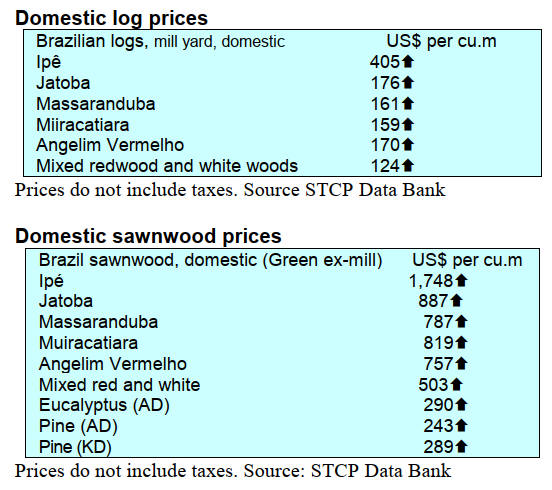
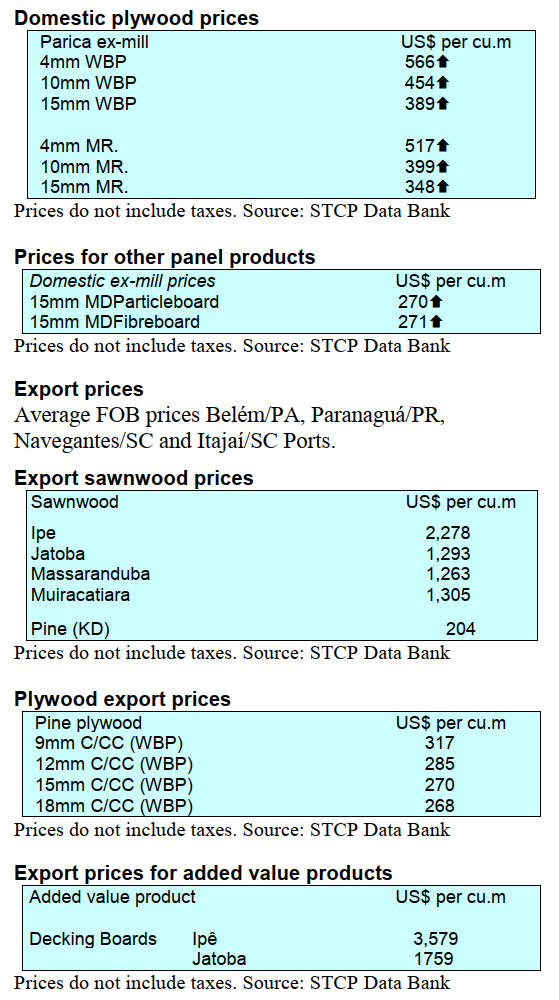
Through the eyes of industry
The latest GTI report lists the challenges identified by the
private sector in Brazil.
See: https://www.itto-
ggsc.org/static/upload/file/20250616/1750055807148798.pdf
9. PERU
Exports at US$21.1
million through April 2025
Shipments of wood products totalled US$21.1 million
during the first four months of 2025 representing a
decrease of 21% compared to the same month in 2024
according to the Center for Global Economy and Business
Research of the CIEN-ADEX Exporters Association.
According to figures from the ADEX Data Trade
Intelligence System exports included sawnwood (US$9.8
million), semi-manufactured products (US$4.1 million),
firewood and charcoal (US$2.8 million), furniture and
parts (US$1.5 million) and construction products (US$1.4
million).
The leading destination was the Dominican Republic, with
shipments totalling US$5.7 million, a 44% increase
compared to the previous year. Viet Nam followed with
US$2.8 million. a 105% increase compared to 2024,
Mexico with US$2.7 million, a decrease of 7%, the United
States with US$2.6 million, a decrease of 31% and closing
the top 5 market was France where exports of US$1.6
million represented a decrease of 59%.
Bosques Amazónicos lists its shares on the Lima
Stock Exchange
Bosques Amazónicos - BAM, a Peruvian company located
in the Ucayali Amazon region specialising in nature-based
solutions, forest conservation, commercial reforestation
and the generation of high-integrity carbon credits
celebrated its listing on the Lima Stock Exchange (BVL)
in early June."This milestone represents the culmination of
almost two decades of work, vision and commitment to
private investment and technology applied to nature,
consolidating BAM as one of the first NatureTechs in
Latin America to achieve this level of projection," said the
Chairman of the Board of BAM.
See: https://www.bosques-amazonicos.com/blog/en/bam-joins-
the-forum-the-route-to-promote-issues-and-issuers-in-the-capital-
markets/
OSINFOR celebrated 17th anniversary
On its 17th anniversary, the Forest and Wildlife Resources
Oversight Agency (OSINFOR) presented an overview of
the progress made in forest oversight, the development of
innovative platformmes that promote information
transparency and capacity-building efforts linked to
oversight.
During a presentation, the head of OSINFOR emphasised
the importance of reflecting on the context of climate
variability that affects health, food production and water
supplies.
In this context, he highlighted the fundamental role of the
Amazon forests which cover nearly 60% of the national
territory as carbon sinks and climate regulators.
“Well-managed forests represent an opportunity to boost
the economy, generate employment and improve the
quality of life for our population,” he stated.
The executive director of the National Forest and Wildlife
Service (SERFOR) emphasised that effective governance
is essential for the advancement of the forestry sector. In
this regard, he highlighted that the strategic compass
promoted by OSINFOR is a key tool for coordinating
efforts and working with a shared vision toward a common
goal.
The president of the Amazon Regional Association
indicated that they are working to provide legal security to
indigenous communities so they can protect their
territories from illegal logging and develop their local
economies while conserving their forests. He also
indicated that the use of certified wood and the formation
of MSMEs are being promoted.
See: https://www.gob.pe/institucion/osinfor/noticias/1195314-
osinfor-cumple-17-anos-con-avances-clave-para-la-
conservacion-de-los-bosques-del-peru
Peru hosts regional workshop on forest statistics for
South America
With the participation of representatives from thirteen
South American countries a Regional Workshop on Forest
Statistics was held in Lima 24 June. The workshop was
organised by the Ministry of Agrarian Development and
Irrigation (MIDAGRI) through the National Forestry and
Wildlife Service (SERFOR) in coordination with the
International Tropical Timber Organization (ITTO) and
the Food and Agriculture Organization of the United
Nations (FAO).
The event aimed to strengthen the technical capacities of
participating countries for the collection, analysis and
reporting of forestry sector statistics through the use of the
Joint Forest Sector Questionnaire (JFSQ) an international
tool designed by FAO, ITTO, Eurostat and the Economic
Commission for Europe (ECE).
The workshop included technical sessions, debates, panels
with representatives from the productive sector, field visits
and exchanges of experiences. Among the topics covered
was the harmonisation of statistical concepts, the
identification of barriers and opportunities and the use of
data in the formulation of sustainable forest policies.
The participating countries included Argentina, Bolivia,
Brazil, Chile, Colombia, Ecuador, Guyana, Paraguay,
Peru, Suriname, Trinidad and Tobago, Uruguay and
Venezuela.
See: https://www.gob.pe/institucion/serfor/noticias/1193748-
midagri-peru-es-sede-del-taller-regional-de-estadistica-forestal-
para-america-del-sur
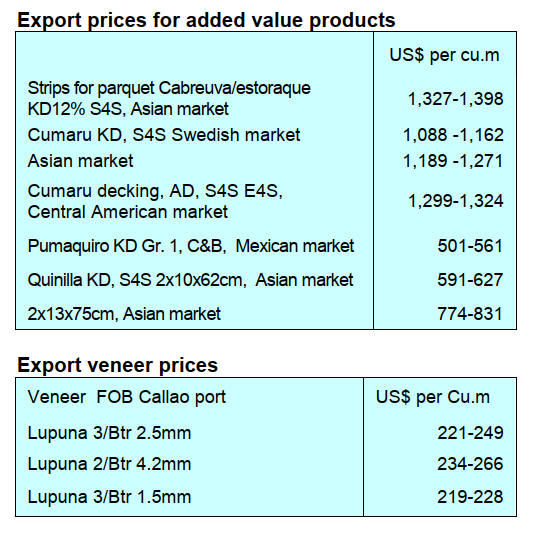
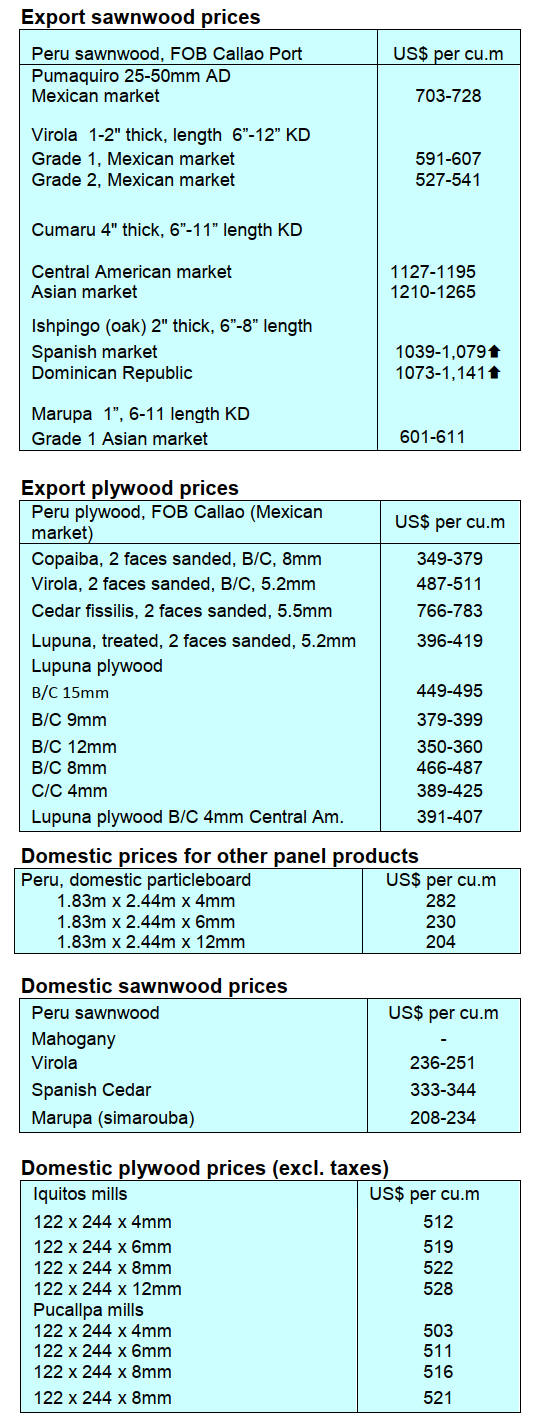
|